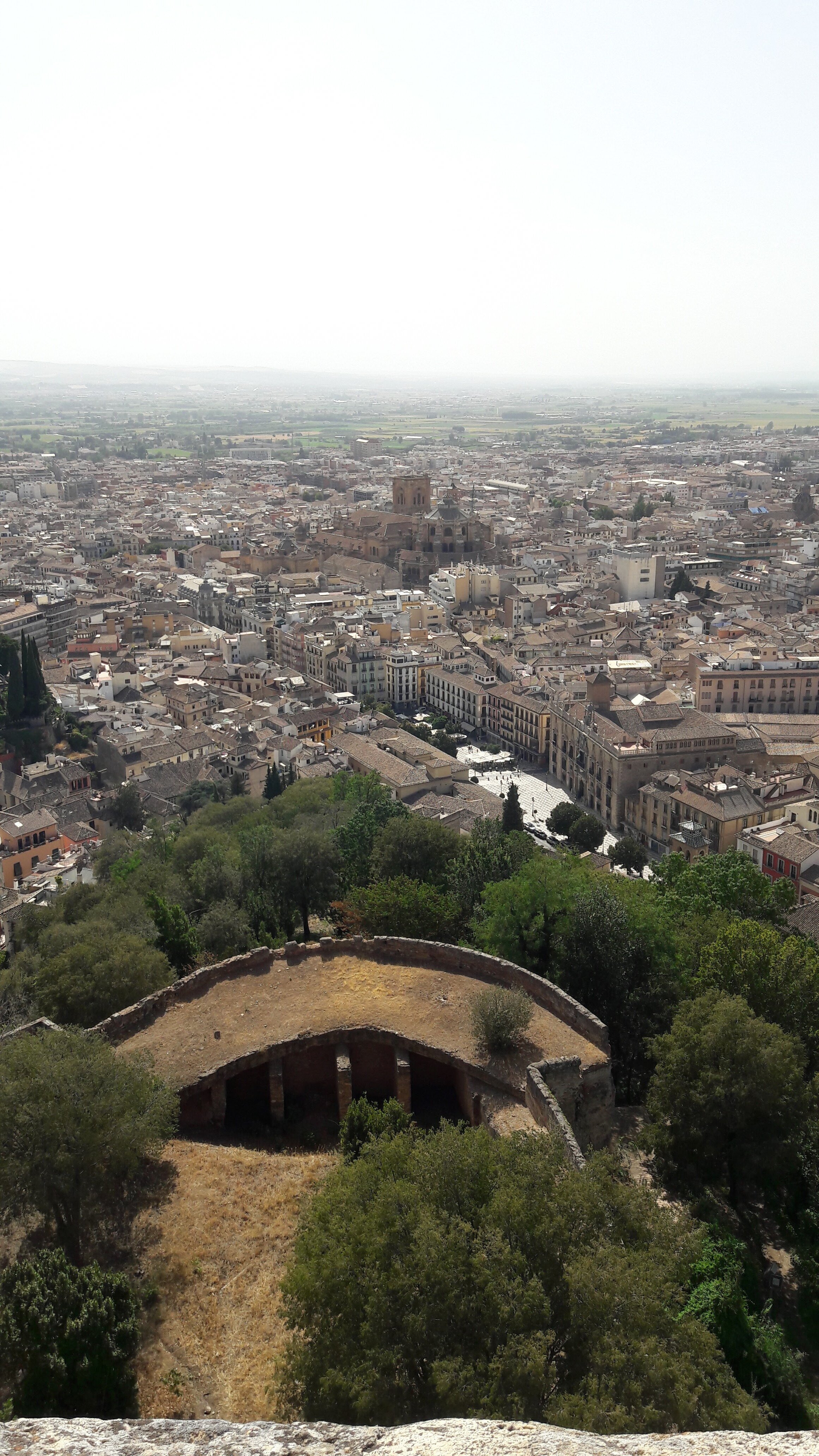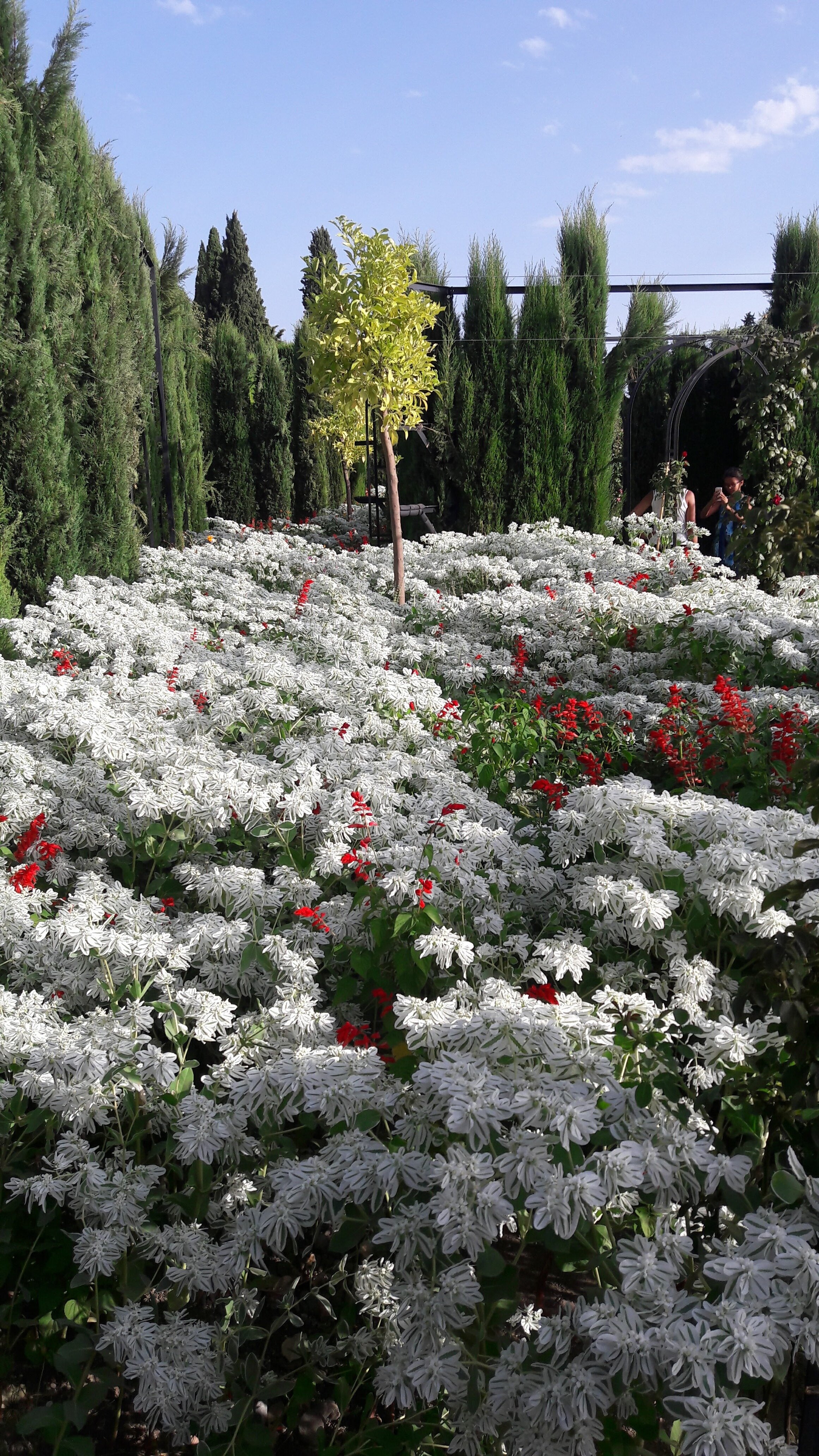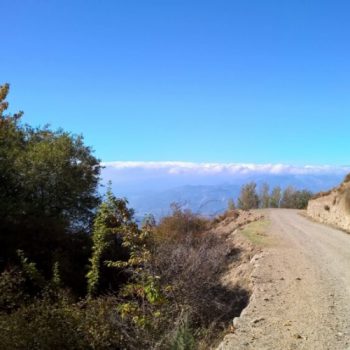
Visiting the Alhambra: Everything You Need to Know
The Alhambra (Granada)
An Overview – The History
 The Alhambra is the most visited tourist site in all of Spain, so it should certainly be at the top of your list as well. While “La Alhambra” is often referred to as a palace, it is indeed much more than that. It can be thought of as a “city within a city” which was built atop a well-protected rocky hill of Granada during the times of Al-Andalus, the last Moorish kingdom in Spain. You can read more about the history of Al-Andalus here.
The Alhambra is the most visited tourist site in all of Spain, so it should certainly be at the top of your list as well. While “La Alhambra” is often referred to as a palace, it is indeed much more than that. It can be thought of as a “city within a city” which was built atop a well-protected rocky hill of Granada during the times of Al-Andalus, the last Moorish kingdom in Spain. You can read more about the history of Al-Andalus here.
The Alhambra—which means “the red one” in Arabic, in which language it should be called Al-Alhambra but is commonly referred to as La Alhambra in Spanish or simply the Alhambra in English—was constructed in the Nasrid period starting in the mid 11th century (although there some portions of the palace that existed previously). The palace and its surrounding community (more details below), was developed over several centuries, under the watch of different rulers.
In 1492, Ferdinand and Isabella, the Catholic Monarchs or los Reyes Católicos as they are known in Spanish, seized the Alhambra in the last battle of the Reconquista, signalling the end of Moorish rule in Spain. While they actually moved into the palaces themselves and maintained some of the original adornment, this was the beginning of the destruction of the original Moorish decor.
During the eighteenth century the Alhambra was abandoned and in the nineteenth century parts of it were destroyed by a French attack and later an earthquake. During this time period the Alhambra fell into a state of neglect and many squatters as well as respected creatives actually took up residence in the palaces, including the famous writer Washington Irving. He actually lived inside of the Alhambra for three months during 1829 when he was collecting stories and legends for his book Tales of the Alhambra (Cuentos de la Alhambra if you choose to read it in Spanish, which we highly recommend!) Since the nineteenth century, the space has slowly been getting restored to its former glory, as the thousands of daily tourists can appreciate.
What to See – The Different Parts of La Alhambra
When looking to purchase tickets to tour the Alhambra, you may be surprised to find that there are many different kinds and be confused by what exactly it is you should choose. Not only will you have your standard options like self-guided vs. audio-guided vs. guided tours, but you will also have the opportunity to choose which parts of the Alhambra you will see. As mentioned above, it truly is a small city and there’s a lot to explore! While we recommend getting a ticket to see all of it if possible, here’s a rundown of the main areas you can find in case you need to make a decision based on time restraints or lack of available tickets.
Los Palacios Nazari (The Nasrid Palaces)
The Palaces make up the most intricate and arguably famous portion of the Alhambra. If you purchase a general ticket with access to everything, this is the only portion for which you need to arrive at a certain time as it is more controlled than the other portions. Inside the Palacios you will find the famous Patio de los Arrayanes (Court of the Myrtles) which houses a large reflecting pond as well as the Patio de los Leones (Court of the Lions) which is where the often photographed fountain of lions can be seen. There are many more rooms and patios to be found in the palaces, but these are two of the most widely known.
 El Generalife (also called “The Generalife” in English, but meaning “Garden of the Architect” in Arabic)
El Generalife (also called “The Generalife” in English, but meaning “Garden of the Architect” in Arabic)
Outside of the Palacios Nazari you’ll find some of the most beautiful labyrinthine gardens called the Generalife. On a sunny day, one could easily spend hours taking in the many peaceful gardens filled with fountains, flowers, and the picturesque scenery. The Generalife offers a unique view looking back to the Alhambra palaces as well down on Granada from above.
La Alcazaba (The Citadel)
This area of the Alhambra is not as awe-inspiring as the other intricately decorated portions but it offers interesting insight into the history of the Alhambra, reminding us that this mini city was built strategically in a place where it could be well-protected and watchmen could notice and prepare for any intruders with fair warning. This section will take you less time to explore but it’s certainly worth a visit due to its age and significance. You’ll notice three flags (those of Spain, Andalusia, and Granada) flying over the watch tower where the flag of the Catholic Monarchs was first raised when Ferdinand and Isabella overtook the palace complex.
El Palacio de Carlos V (The Palace of Charles V)
Under the rule of Charles V, much of the Alhambra’s original decoration was torn down and rebuilt in the Renaissance style of the period. He also made room for and began to construct this Renaissance-style structure that bears his name. However, he eventually lost interest and it was never fully completed. It was not until the twentieth century that the roof was even added. Needless to say, this section of the Alhambra thus feels a bit underwhelming and out-of-place next to the detailed and colorfully restored palaces but it’s worth a quick peek inside for the sake of comparison.
La Medina (The Medina)
This section of the Alhambra was mostly destroyed during the War of Independence (also known as the “Peninsular War”), but the foundations of buildings, walls, and public baths can be observed to form a half-picture of the public space this once was. The Medina is often the most overlooked portion of the Alhambra for those moving between the different sections included in their ticket however it is especially valuable to those who are not able to obtain tickets as it is completely free and open to the public! For this reason, even if you don’t manage to get tickets to the other portions, we still recommend taking the hike up to the Alhambra and getting a taste of it all from the free portions.
 How to Prepare for your visit
How to Prepare for your visit
Purchase your ticket in advance!
It is especially important to plan your visit and buy tickets ahead of time if you are coming during tourist season (ie. during the summer months, Semana Santa, or the Christmas / New Years holiday). Before doing so, you should decide if you want to take a guided tour or an audio tour. Remember, this palace complex has been part of Granada for longer than Spain has been an official country, making it a space full of history and wonder. If you are here for a short period of time and enjoy learning, we would definitely recommend doing some sort of tour! On the official Alhambra website, you can purchase general entrance (to all or some parts) but this does not include a guided tour. If you’re interested in being led by another human (and being able to ask them your questions) you ought to splurge for a guided tour through a separate company.
But if you didn’t purchase in advance…
Don’t panic—you’ve still got options! Organizations that offer guided tours (although much more expensive than the standard ticket, approximately 50€) provide a great alternative and generally have more availability of tickets than what you will find on the official site. If you’re more budget-conscious, you can try refreshing the official website for awhile at midnight the day before you want to visit in hopes that you catch day-of tickets right after they are released. If that doesn’t work, however, you may just have to make the trek up to the ticket office early in the morning that day to claim a day-of ticket in person. Of course ‘early’ is a subjective term—some people have told us they’ve been there at 7:00 and not had luck whereas others have claimed they strolled up at 9:00 and got some. It seems to be the luck of the draw, but take into consideration the popularity of the time of year you’re visiting. Finally, one other option is to purchase a bono-pass for the city (these sell for approximately 40€, but include access to the Alhambra and Generalife, public transport, and a number of other famous sites).
 Plan to make the most of it
Plan to make the most of it
The Alhambra is something you can see in half-a-day, we would recommend not rushing it too much and truly enjoying the time you have inside. We have actually been to the Alhambra more times than we can count (residents can get in free on Sundays and we love accompanying our visitors) and one of our favorite things is to go with a packed lunch and hang out in the gardens. You can stay inside until the end of your ticket period (generally 14:00 for the morning ticket or 18:00 or 20:00, depending on the season, for the afternoon ticket) so why not make the most of it? Take advantage of this beautiful place and be prepared to spend a decent number of hours here—although, if this is your plan, bring your own food as there is only one or two stands in the whole complex and they serve overpriced food and drinks.
How to get there
There are several ways to reach the Alhambra. If you are coming with a tour from another city, your bus will most likely drop you at the entrance. If you traveling in on public transport and wish to continue on local buses or trams you can catch the 21 or 33 bus from either the bus station or the train station and get off at the Cathedral. Then, walk just a few minutes down to Plaza Isabel la Católica, where you can catch the C30 or C32 bus up to the Alhambra.
Alternatively, if you are already in the city center (ie. the Cathedral), and can manage, we recommend walking up the hill Cuesta de Gomérez from Plaza Nueva (or at least walking down the hill) as it will offer you a complete picture of the surrounding area. It is a very steep incline, however, so give yourself enough time to rest and take in the scenery on your way there. If you are in the city center and don’t want to walk the hill you can either take a taxi (between 5 and 10€) or the C30 or C32 bus (1.40€). If you’ve purchased a ticket for the hop-on hop-off bus you can take that as well!
 Recommended time of year to visit
Recommended time of year to visit
The Alhambra is both beautiful and packed with visitors year round. We would personally recommend coming in the early winter, around the end of November or beginning of December (not too hot and less tourist than normal) and going during the week if you can manage it to keep the number of tourists to a minimum. However, we must admit that visiting in the summer (though sometimes unbearable in terms of the heat and crowds) allows you to see the gardens in the fullest of bloom.
Do you have any other questions about visiting the Alhambra? Drop them below and we’d be happy to answer them!
Resources:
https://www.alhambradegranada.org/en/info/historicalintroduction.asp
https://www.britannica.com/topic/Alhambra-fortress-Granada-Spain
https://en.wikipedia.org/wiki/Alhambra#Main_structures
https://www.alhambra.org/en/alhambra-parts.html
https://tickets.alhambra-patronato.es/en/





4 Comments
adamslaurel2@gmail.com
Typo!!! The palace was seized in 1492 not 1942.
Sincerely, Spain
Oh my goodness, that was a big typo…Thanks for catching it!
Kevin Smith
Hi Ladies, can you include from the railway station in your ‘How to get there’ section? Many thanks
Sincerely, Spain
Hi Kevin,
Thanks for your suggestion. The train station was actually not running any trains at the time we originally wrote this post, but we have now updated that section to include directions from both the train station and bus station.
Cheer,
Dani and Claudia